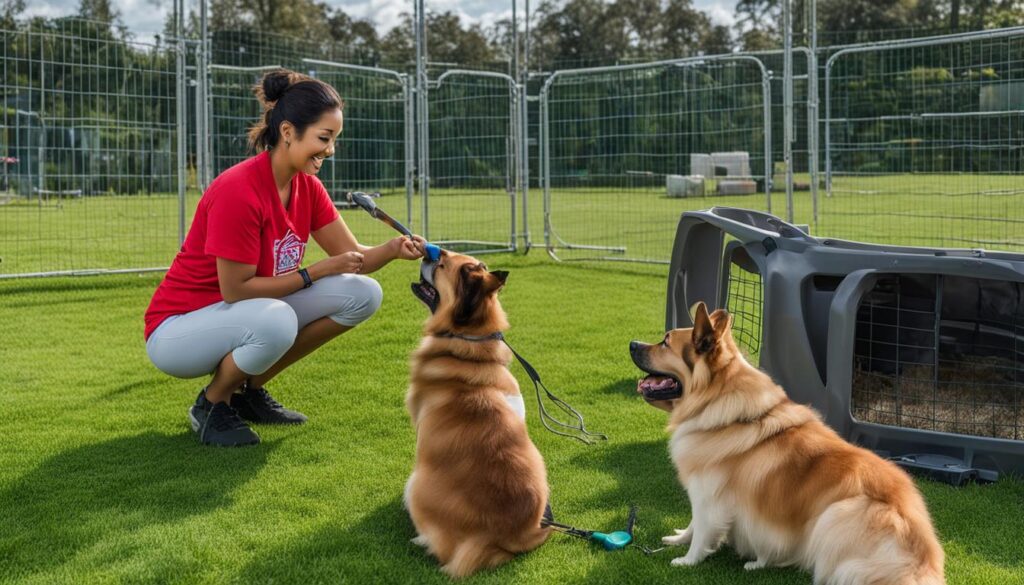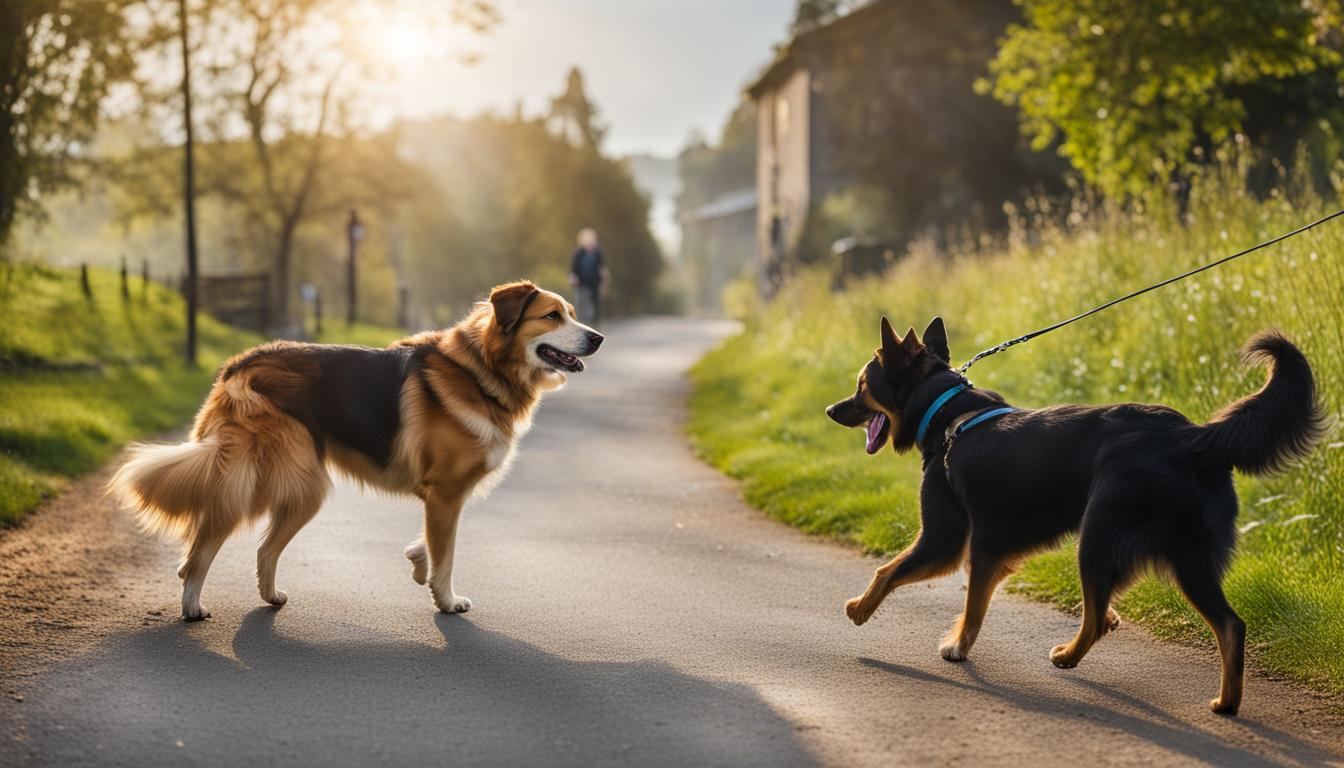Welcome to our comprehensive guide on building trust in dog training sessions. Developing a strong bond based on trust is essential for effective training and a harmonious relationship with your furry companion. Whether you’re working with a fearful dog or simply want to deepen the trust and respect between you and your canine friend, this article will provide you with valuable insights and techniques to achieve your goals.
Key Takeaways:
- Nurturing trust is vital for a stronger bond between you and your dog.
- Understanding your dog’s body language and respecting their space are crucial in building trust.
- Consistency, positive reinforcement, and providing a safe space are key elements in establishing trust.
- Rescue dogs and dogs with trust issues require extra patience and understanding.
- Trust impacts a dog’s mental health, influencing their confidence and overall well-being.
Reasons Your Dog Can Have Trust Issues
Dogs can have trust issues for various reasons, which can make it challenging to build a strong bond with them. Understanding these reasons and using trust-based training approaches can help you develop trust with your dog, particularly rescue dogs.
Lack of socialization is one common reason for trust issues in dogs. If a dog hasn’t been exposed to different people, animals, and environments during their critical socialization period, they may struggle to trust new experiences later in life. This lack of exposure can make them fearful or anxious in unfamiliar situations.
Another factor that can contribute to trust issues in dogs is past trauma or abuse. Dogs that have been mistreated in the past may find it difficult to trust humans again. Their previous experiences may have led to fear or aggression, making it important to approach them with patience and understanding.
Rescue dogs, in particular, often come from challenging backgrounds, including neglect or abuse. They may have experienced a lack of trust and stability in their previous homes, which can make it harder for them to build trust in their new environment. Adopting trust-based training approaches can help these dogs feel safe and secure as they adjust to their new life.
| Reasons for Trust Issues in Dogs | Trust-Based Training Approaches |
|---|---|
| Lack of socialization | Gradual exposure to new experiences |
| Past trauma or abuse | Approach with patience and understanding |
| Rescue dogs | Provide a safe and secure environment |
How Trust Impacts a Dog’s Mental Health
Building trust plays a vital role in a dog’s mental health and overall well-being. When dogs trust their owners, they feel safe, secure, and confident, which promotes positive behaviors and emotional stability. Trust creates a strong foundation for a mutually respectful and loving relationship between you and your furry friend.
Dogs that trust their owners are more likely to seek out interactions, engage in training sessions, and exhibit excitement in their daily activities. They feel comfortable approaching their owners for affection and support, knowing they will be met with kindness and understanding. This emotional connection between owner and dog is crucial for effective communication and successful training.
“When a dog trusts its owner, it becomes more receptive to learning and following commands. Trust is the key that opens the door to a harmonious and fulfilling partnership.”
On the other hand, anxious and fearful dogs may lack trust, leading to avoidance behaviors, excessive stress, and difficulty in developing social skills. These dogs may withdraw from interactions, exhibit aggression, or display signs of fear and anxiety. By building trust in dog training, you can help these dogs overcome their insecurities, gain confidence, and improve their overall mental well-being.
The Importance of Strengthening the Owner-Dog Relationship in Training
Strengthening the owner-dog relationship through trust-based training is a crucial aspect of successful dog training. When you establish trust with your dog, you create a strong bond that encourages cooperation, enhances learning, and fosters a deeper emotional connection. Dogs that trust their owners are more likely to respond positively to training techniques and readily learn new behaviors.
By prioritizing trust in dog training, you strengthen the foundation of your relationship with your dog. Trust allows you to effectively communicate with your furry friend, understand their needs and preferences, and establish clear boundaries. This mutual trust and understanding form the basis for a solid partnership built on love, respect, and shared experiences.
When trust is established, both you and your dog can enjoy a fulfilling and enriching training journey. Your dog will feel safe and loved, knowing that you have their best interests at heart. Together, you can overcome challenges, achieve training goals, and forge a lifelong bond that will bring immeasurable joy and companionship.
How to Build Trust with Your Dog
Building trust with your dog is essential for a strong and harmonious bond. By using specific techniques and approaches, you can establish a solid foundation of trust in your training sessions. Here are some strategies to help you establish a bond during training and earn your dog’s trust and respect.
1. Understand Your Dog’s Body Language
Learning to read your dog’s body language is crucial in building trust. Observe their facial expressions, tail position, and overall posture to understand their emotions and level of comfort. This will help you gauge when they are feeling stressed, fearful, or relaxed. By recognizing and responding appropriately to their signals, you can create a safe and secure environment for your dog, enhancing trust.
2. Respect Your Dog’s Space
Respecting your dog’s personal space is key to building trust. Allow them to approach you at their own pace and always ask for permission before petting or hugging. Avoid overwhelming your dog with excessive physical contact, especially if they show signs of discomfort. By giving your dog space and control over their interactions, you demonstrate respect, which is fundamental in fostering trust.
3. Use Positive Reinforcement and Consistency
Positive reinforcement is a powerful tool in building trust. Reward your dog for desired behaviors, such as following commands or exhibiting calmness. This approach creates a positive association with training and reinforces their trust in you. Consistency is also vital in building trust. Establish clear rules and expectations, and follow through consistently. This helps your dog understand what is expected of them and builds their confidence in your leadership.
Building trust with your dog takes time and patience. By understanding their body language, respecting their space, and using positive reinforcement, you can establish a strong bond and earn their trust and respect. Remember, trust is the foundation of a successful training relationship, and with consistency and kindness, you can nurture a deep and lasting connection with your furry friend.

Trust-Building Activities in Dog Training
Deepening the connection with your dog through training is essential for building trust. Engaging in trust-building activities not only strengthens your bond but also promotes positive behavioral development. Here are some activities that can help deepen the connection with your dog and develop trust, especially in rescue dogs:
- Positive Associations: Create positive associations with your presence by rewarding your dog when you are near. Offer treats and praise when you approach, reassuring them that your presence is enjoyable and safe.
- Reinforce Calm Behavior: Encourage calm behavior by rewarding your dog when they are relaxed and composed. This helps them associate calmness with positive reinforcement, promoting a sense of trust and security.
- Play Games: Playing interactive games, such as hide-and-seek or puzzle toys, can be a fun way to build trust. These games provide mental stimulation and bonding opportunities, strengthening the connection between you and your dog.
“Trust is built through engagement and positive experiences. By incorporating trust-building activities into your training sessions, you create a dynamic where your dog feels safe, understood, and valued.”
For rescue dogs, trust-building activities may require additional patience and understanding. Gradual exposure to new environments and positive experiences can help these dogs develop trust. Remember to always approach these activities at your dog’s pace, keeping in mind their individual needs and past experiences.
By incorporating trust-building activities into your training routine, you can deepen the connection with your dog and create a solid foundation of trust. These activities not only strengthen the bond between you and your canine companion but also enhance the overall training experience.

Consistency and Routine in Dog Training
Consistency and routine are key elements in building trust and strengthening the owner-dog relationship in training. Dogs thrive in environments where they know what to expect, and consistency provides them with a sense of security and stability. By establishing a consistent schedule for feeding, walking, and play sessions, you create a routine that your dog can rely on, helping them feel more comfortable and at ease.
Consistency also extends to the commands and expectations you have for your dog. Using consistent language and hand signals for cues and commands will help your dog understand what is expected of them and reinforce desired behaviors. By following through with consistent expectations, you build trust with your dog, as they learn that they can rely on you for guidance and consistency.
Patience plays a crucial role in building trust through consistency and routine. Rushing progress can lead to confusion and undermine the trust you are trying to build. It’s important to allow your dog time to learn and adjust to the routine, understanding that each dog has their own pace. By being patient and understanding, you demonstrate to your dog that you respect their individual needs and build a stronger bond.
| Benefits of Consistency and Routine in Dog Training |
|---|
| 1. Security and Stability – Consistency and routine provide a sense of security and stability for dogs, allowing them to feel more comfortable and at ease in their environment. |
| 2. Reinforced Learning – Consistent commands and expectations reinforce learning and help dogs understand what is expected of them, building trust and confidence. |
| 3. Stronger Bond – By being consistent in your interactions and routines, you build a stronger bond with your dog, as they learn to trust and rely on you. |
Consistency and routine are essential components of effective dog training. By providing structure, adhering to consistent commands and expectations, and demonstrating patience, you can establish trust and strengthen the owner-dog relationship. Remember, building trust takes time, and consistency is the key to success.

Healthcare and Grooming for Trust-Building
Proper healthcare and grooming are essential aspects of building trust with your dog. By prioritizing their physical well-being and ensuring their comfort, you can strengthen the emotional connection between you and your canine companion. Regular veterinary check-ups, vaccinations, and addressing any health concerns promptly demonstrate your commitment to their overall well-being.
Grooming also plays a crucial role in building trust. Regular bathing, brushing, and nail trimming help your dog feel comfortable and secure. It allows you to build a positive association with grooming activities, making them less stressful for your dog. Take the time to introduce grooming gradually, using positive reinforcement and providing treats or praise to create a positive experience.
“Proper healthcare and grooming are essential aspects of building trust with your dog.”
When grooming your dog, pay attention to their body language and take breaks if they show signs of discomfort or stress. Use gentle and soothing methods to create a calm environment. Remember to be patient and understanding, allowing your dog to adjust to the grooming process at their own pace.
| Grooming Tips | Benefits |
|---|---|
| Regular bathing | Maintains hygiene and eliminates odors |
| Brushing | Reduces shedding and promotes healthy skin and coat |
| Nail trimming | Prevents overgrowth and discomfort |
By attending to your dog’s healthcare needs and ensuring proper grooming, you show them that their well-being is a priority. This fosters trust, as your dog feels safe and cared for. Building trust through healthcare and grooming strengthens the bond between you and your dog, creating a foundation for a harmonious and trusting relationship.

Conclusion
Building trust in dog training is a journey that requires time, patience, and understanding. By implementing various techniques such as reading your dog’s body language, respecting their space, and using positive reinforcement, you can lay the foundation for a strong and trusting relationship with your furry friend.
Consistency and routine are key in reinforcing trust and desired behaviors. By maintaining a consistent schedule for feeding, walking, and play sessions, you provide your dog with structure and a sense of security. Consistent commands and expectations also contribute to a stronger owner-dog relationship, built on trust and mutual understanding.
In addition to training, proper healthcare and grooming are essential for building trust. Regular check-ups with a veterinarian, vaccinations, and attentive monitoring of your dog’s health demonstrate your commitment to their well-being and strengthen the emotional connection between you and your canine companion.
Building trust in dog training is not only about teaching commands, but also about establishing a deeper bond between you and your dog. Trust is the vital ingredient that allows for effective communication and lifelong learning. By investing time, care, and love, you can create a harmonious partnership based on trust and strengthen the owner-dog relationship in training.
FAQ
What are some common reasons why dogs can have trust issues?
Dogs can have trust issues due to various factors such as lack of socialization, past trauma, or genetics. Rescue dogs, in particular, may require extra patience and understanding as they adjust to a new environment.
How does trust impact a dog’s mental health?
Trust plays a significant role in a dog’s mental health. Dogs that trust their owners are more confident, seek out interactions, and show excitement and engagement. Anxious and fearful dogs may exhibit avoidance behaviors and lack interest in interacting.
What are some techniques to build trust with your dog?
To build trust with your dog, it’s important to learn their body language, respect their space, and let them set the pace. Consistency, positive reinforcement, and providing a safe space are key in establishing trust with your dog.
What are some trust-building activities in dog training?
Engaging in positive associations with your presence, reinforcing calm behavior, and playing games can help build trust in dog training. Basic shaping games and rewards-based training are effective approaches.
Why is consistency and routine important in dog training?
Consistency and routine are vital in dog training to establish trust and reinforce desired behaviors. They provide structure and help dogs feel secure. Consistent commands and expectations from the owner also contribute to a strong owner-dog relationship.
How does healthcare and grooming contribute to trust-building with your dog?
Providing proper healthcare and grooming shows your dog that you care for their well-being and establishes a deeper emotional connection. Regular check-ups with a veterinarian and grooming routines help your dog feel comfortable and foster trust.





